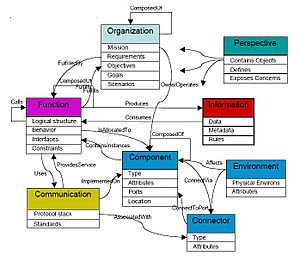Military taxonomy facts for kids

A military taxonomy is like a super organized system for sorting and understanding everything about military operations. Think of it as a special way to categorize and list all the important details. This system helps keep track of things like weapons, military equipment, different organizations, big-picture plans, and specific tactics (the actions taken).
This organized list helps people in the Military understand and analyze different field missions and other activities. For example, if you were to create a taxonomy about a specific topic like "peacekeeping missions," it would include terms for the types of soldiers involved, their gear, the groups they work with, and the steps they take.
Having a clear taxonomy helps everyone use the same terms and understand what each part means. This makes it easier to study and improve military strategies and actions.
Contents
What is Military Taxonomy?
A military taxonomy is a special kind of index or record-keeping tool. It helps organize a huge amount of information related to military activities. Imagine trying to sort a giant collection of toys without any labels or categories – it would be a mess! A taxonomy does this sorting for military information.
It helps define and group different elements. This includes everything from the smallest piece of equipment to the largest military organization. It also covers how military actions are planned and carried out.
Why is it Used?
The main reason for using a military taxonomy is to make sense of complex information. When you have a clear system for categorizing things, it becomes much easier to study, plan, and communicate. It ensures that everyone involved understands the same terms in the same way.
For example, if different units use different names for the same type of weapon, it could cause confusion. A taxonomy provides a standard list of terms. This helps with training, logistics (getting the right supplies to the right place), and even understanding past events.
How Does it Help Analysis?
One of the most important uses of military taxonomy is for analysis. By breaking down military actions and situations into defined categories, experts can study them more effectively. They can look at patterns, identify strengths and weaknesses, and learn from past experiences.
For instance, if you want to analyze how a certain type of mission usually goes, a taxonomy helps you categorize all the parts of that mission. This could include the type of terrain, the number of people involved, the equipment used, and the specific actions taken. This structured approach helps in making better decisions for future operations.
Examples of Taxonomy in Action
To understand military taxonomy better, let's look at a simple example. Imagine a taxonomy for "military vehicles." It might start with broad categories and then get more specific.
Categorizing Military Vehicles
- Ground Vehicles
- Tanks
- Main Battle Tanks
- Light Tanks
- Armored Personnel Carriers (APCs)
- Logistics Vehicles (trucks, supply vehicles)
- Tanks
- Air Vehicles
- Fighter Jets
- Transport Aircraft
- Helicopters
- Naval Vessels
- Aircraft Carriers
- Submarines
- Destroyers
This simple example shows how a taxonomy helps organize information. Each item fits into a specific place, making it easy to find and understand.
Analyzing Military Strategies
Military strategies are like big plans for achieving a goal. A taxonomy can help break down these strategies into smaller, understandable parts. For example, a strategy might involve different phases, types of forces, and specific objectives.
By using a taxonomy, military planners can clearly define each part of a strategy. This helps them to see how all the elements connect and how they might affect each other. It also makes it easier to explain the strategy to others and to measure its success.
The Importance of Clear Definitions
For any taxonomy to work well, the definitions of its terms must be very clear. If terms are vague or can be interpreted in different ways, the whole system becomes less useful. Imagine if "tank" could mean a battle tank or a water tank – that would be confusing!
Every term in a military taxonomy has a precise definition. This ensures that when someone refers to a "reconnaissance mission," everyone understands exactly what that means. Clear definitions are key to effective communication and analysis in the military.

